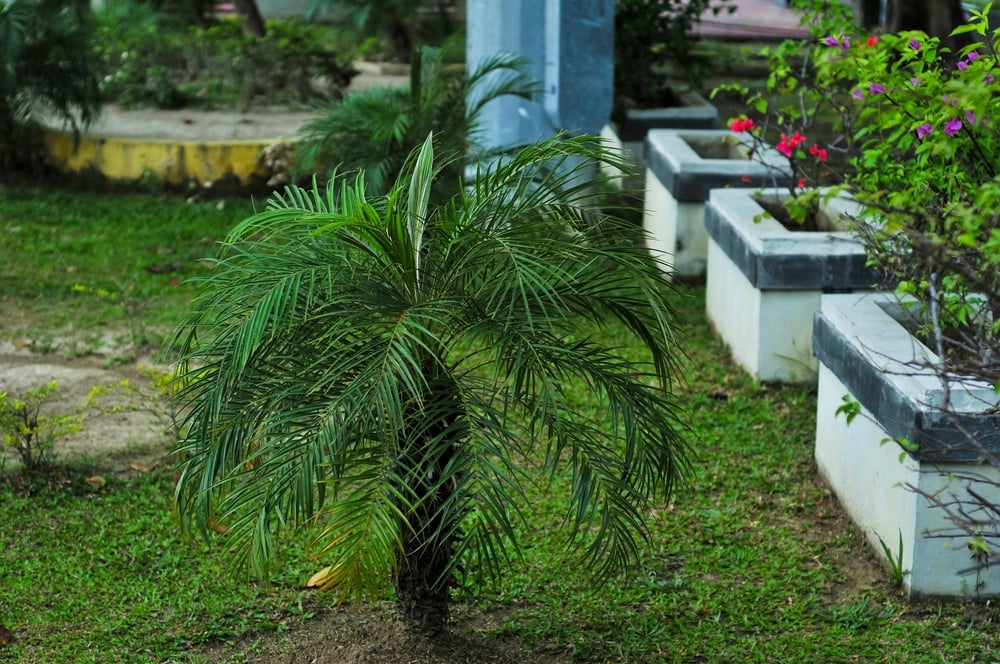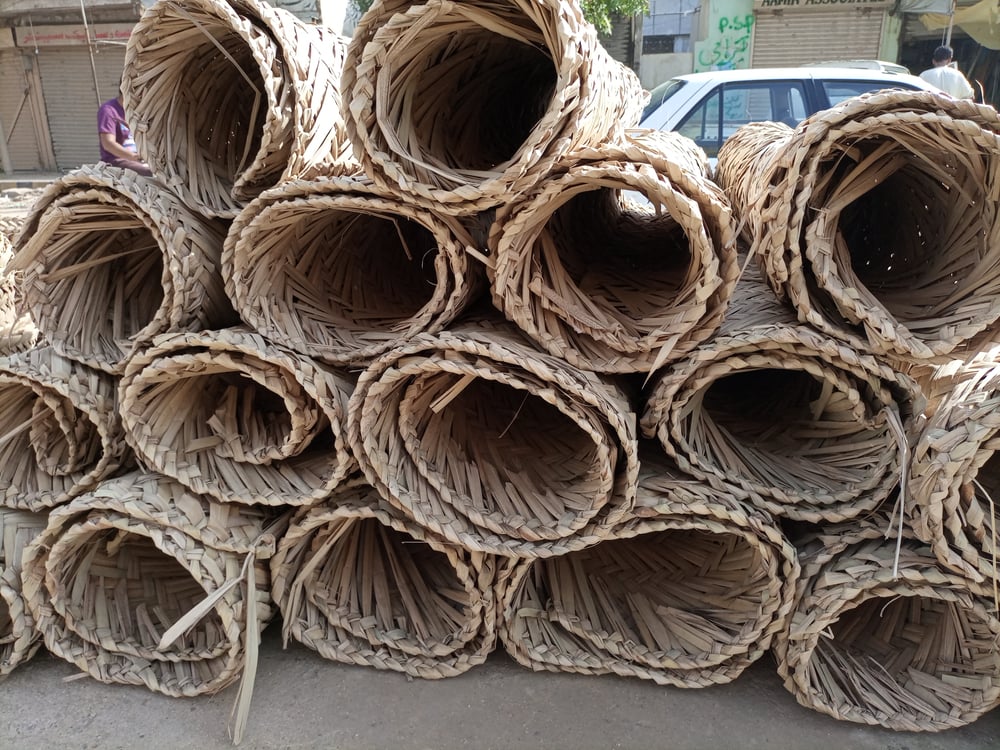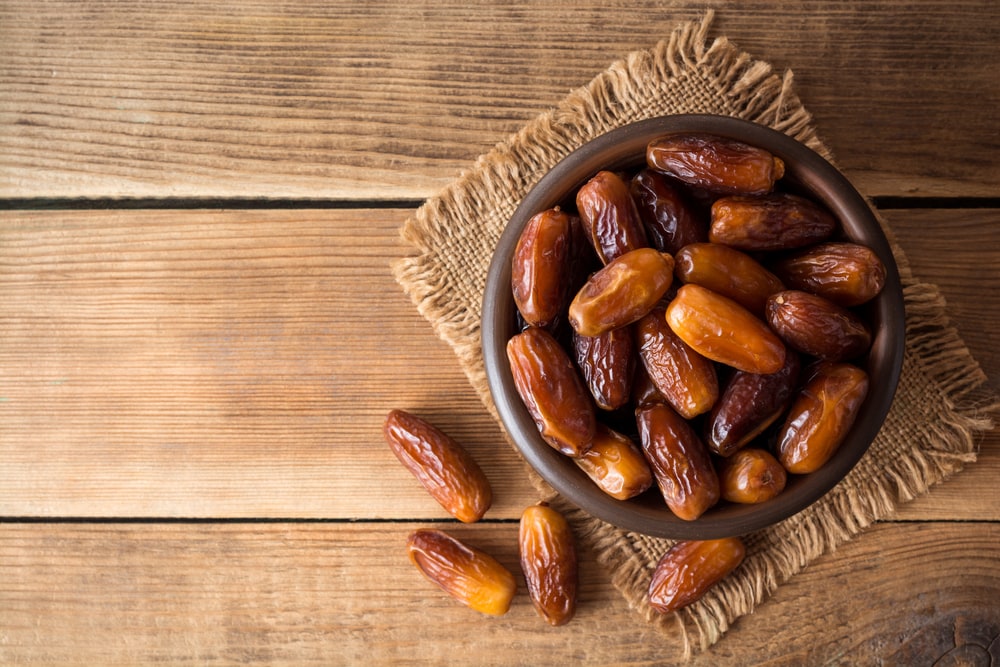Outforia Quicktake: Key Takeaways
- Pygmy date palm (Phoenix roebelenii) is a small palm tree native to southern China, Laos, and Vietnam
- Grows to a height of 6-8 ft (1.8-2.4 m), with vibrant green leaves and small, purple, edible date-like fruits
- Valuable as a decorative plant and provides economic benefits such as edible fruit, fiber, and wine production
- Pygmy date palm seeds can be germinated, taking 3 months and can be grown indoors or outdoors
- The palm has various uses, including rope making, thermal insulation, building materials, and medicinal purposes

For anyone who’s into houseplants, or plants in general, the Pygmy Date Palm (Phoenix roebelenii) is a classic choice for the home. It actually hails from the warm humid region of the Mekong River in China.
Though it grows to only 2m (6.5 ft), it’s a true palm, being a member of the Arecaceae palm family. There are roughly 2,600 different types of palm trees! There’s only 17 in the Arecacaea family though. They’re an exclusive bunch!
You May Also Like: Unveiling 25+ Stunning Tropical Rainforest Plants: Nature’s Wonders
Pygmy Date Palm Characteristics

See a palm while traveling and want to know if it’s a Pygmy Date Palm? Here’s the lowdown on how to recognise one!
The Pygmy Date Palm typically grows to a height of 6-8 ft (1.8-2.4 m), making it an excellent choice for those who want a small tree for their yard or garden.
The leaves of the Pygmy Date Palm are fine, soft, and frond-like, measuring 2-4 ft (61 cm-1.2 m) long. They are a vibrant green color and have small spines at the base, which can be prickly to the touch.
The Pygmy Date Palm produces small yellow flowers on long stalks. These flowers are not particularly showy, but they add an interesting element to the palm’s appearance.
The Pygmy Date Palm produces small, purple date-like fruits, but only if the plant is female. The fruit is edible, but it is not particularly tasty, and it is not often used for culinary purposes.
The trunk of the Pygmy Date Palm is bumpy and has a gray to brown color. As the palm grows, older leaves drop off, leaving behind the distinct markings of where they were attached to the trunk.
Below you can see the clumps of fruits hanging from a female plant.
Wild pygmy date palms have a single straight trunk. Cultivated pygmy date palms are often planted in clumps of 3 or 4. When this happens the trunks grow curving away from each other. This can look very pretty!
Where is Pygmy Date Palm Found?

Pygmy Date Palm is native to Southern China, Laos and Vietnam. It grows along the banks of the Mekong River, where the climate is warm and humid.
Pygmy Date Palm grows in many places worldwide nowadays. It is a popular landscaping plant! You can see it growing in America, including Louisiana, Georgia, Arizona, Alabama, Arkansas, the Mississippi, Texas and Oregon.
You’ll most often find it growing in the wild on sunny or partially shaded riverbanks. Though you can find the tame version planted in backyards and front yards in warm places, and in houses all over the world!
Most garden centers sell Pygmy Date palm, so even if you are stuck at home you won’t have to travel far to find it!
Below you can see the Pygmy Date Palms’ beautiful homeland – The Mekong River.
How Important is the Pygmy Date Palm?

Date palms as a group of plants have high economic value. They not only produce edible fruits that are high in useful sugar, but you can get fiber and wine from them too! Global production of date palm reaches 8 million tons a year.
This concerns all the date palm species and not just Pygmy Date Palm, but you get the idea!
Pygmy Date Palm is mostly valuable to the economy as a decorative plant.
Date palm fiber can be used to make:
- Ropes
- Thermal insulation
- Evaporative cooling equipment

Date palm fruit and juice is used for:
- High energy food
- Medicine – date palm fruit is used for coughs and breathing problems. It contains a lot of fiber, which helps with digestion. However, more studies need to be done before this is proven, as there isn’t enough evidence at present.

What we do know is that date palm is safe to use as a tasty food! We’ll have a look at each of these uses of date palm in more detail below.
The Nutritional Value Of Dates

Date fruit contains an awful lot of calories due to the sugars.
Did you know dates also contain these nutrients per 100g (based on Medjool dates):
- 277 calories
- 75 g of carbs
- 15% DV of potassium
- 40% of DV of copper
- 13% of manganese
- 13% of magnesium
- 15% of vitamin B6
- 5% DV of iron
A whopping 40% of the daily copper your body needs! That’s not to be sniffed at!
I’ve picked ripe fresh dates from palms in Gran Canaria, one of the Canary Islands. They were the best dates I’ve ever tasted. They went amazingly well with a crusty roll spread with tangy goat’s cheese!
What Can Date Palms Be Used For?
Date Palm Rope

Palm fiber is tough and strong. It’s used in the UAE, Mauritania, Morocco and all over the world to make palm fiber rope. This is handy next time you are in palm tree territory and need to lash together a raft! So, how do you make a rope out of date palm?
The part of the palm to use for rope is actually the trunk fibers, not the leaves. This is peeled off in sheets and the fibers separated.
So you’re on your desert island, and you need rope. This is what you do!
- Soak your palm fibers in water then dry them.
- Rub and twist them by hand to create long strands.
- Twist two parts sound each other to form a braid.
- Tighten the two braids using palm leaf sticks.
Here you can see palm fiber rope being used to secure the bamboo beams of a house:
Insulating With Date Palm Fiber

Date palm fiber has very good insulative properties. It is used to make insulation for commercial construction projects. This creates an ecologically sound construction material that can be part of the sustainable circular economy.
There are many processes involved in making a date palm composite building insulation. This means date palm fibers mixed with something else! Some of these processes are annealing, melt blending, and compression molding.
A palm fiber composite has been made that uses completely non toxic materials. The binding agent is polyvinyl alcohol. This is better known to generations of schoolchildren as PVA glue!
Test results from one study showed the thermal conductivity of composite insulation increased with the amount of Date Palm Fiber used.
The conclusion overall, though, was that date palm fiber is a good alternative to more traditional building insulation. It is cheap and a lot more eco-friendly!
Other Uses of Date Palm Fiber

Date palm fiber from P.canadensis, a cousin of Pygmy Date Palm, can be used for evaporative cooling equipment.
It is also being used for parts of cars! This study found that date palm fibers possess a strength comparable to aluminum alloys and E glass fibers! So automotive companies are developing and using palm fiber.
The palm fiber is used in thermosetting and thermoplastics within car bodies. Thermoplastics are polymers that can be heated and formed, then heated and reformed again and again! Handy, and great for recycling!
It’s also being used for sound insulation.
Below is a car mudguard made out of a (conventional) thermoplastic. Palm fiber can replace these plastic parts and create part of a sustainable, recyclable car!
Palm Wine

Indigenous peoples from date palm areas often make use of the ‘juice’ of the date palm. This isn’t juice from the date fruits. It’s sap from the trunk area of the tree!
Date palm sap is sweet and can be fermented to make palm wine! Palm sap isn’t alcoholic, but it starts fermenting immediately as soon as it’s extracted from the tree.
Within 2 hours it has an alcohol content of 4%, like a standard beer! It can ferment for a day. When distilled it gets stronger and stronger, up to 45% proof!
The sap is collected by hand. The harvester makes a ‘V’ shaped cut in the trunk until the sap oozes out. They then carve a channel and place a tube to drain the sap into a bottle.
Palm wine is made in many parts of Africa, India, and the Philippines.
The Life Cycle of a Pygmy Date Palm
So how do Pygmy Date Palms grow and develop? Here’s the life story of a pygmy date palm!
Pygmy Date Palm Seeds

Date fruits are dropped from a mature Pygmy date Palm. Even if they are old, they will still germinate if kept in the right damp and humid conditions.
In the wild, the tasty date fruit around the seed would be eaten by an animal and carried off or pooped out in a suitable location! Birds, fruit bats, insects and antelope will all eat dates, as well as humans.
Sometimes the pygmy date palm seed has boring beetle eggs and larvae in the flesh. These will eat the seed. If not, the seed will start to germinate in around 3 months. In captivity, you can dust the seeds with insecticide to stop this from happening.
After being saturated in water for several days, the seeds are ready to germinate. If the seed is buried in a place with good drainage, lots of sunlight and shelter from the wind, it will begin to grow.
Adult Life and Reproduction

In spring, the female pygmy date palm produces long stalks. These are topped with creamy white flowers. Pygmy date palms are dioecious – this means trees are either male or female, but not both!
The flowers are pollinated by pollen from male trees. The pollen is carried by the wind in the wild. Cultivated date palms are pollinated by humans.
In autumn, dates form in big clusters of 10 to 13 below the leaves. They are oval-shaped and turn red brown to dark purple when they’re ripe. Pygmy date palms have only a thin layer of fruit over the seed.
The cycle begins anew when more animals arrive to eat the dates.
You May Also Like: Are Pine Cones Edible? Discover The Surprising Truth
History of Date Palms

- Members of the Arecaceae palm family have been around for 80 million years. They were living alongside (and probably being munched on by) the dinosaurs of the Cretaceous period.
- Date palms have been discovered in the fossil record. The fossils are 50 million years old. So they’ve been around a while. What a shame the dinosaurs missed them!
- Date palms (P.dactylifera) are the world’s oldest cultivated tree. They were grown and harvested in the 5th century in Ancient Egypt and Mesopotamia. Ancient Egyptians used a hieroglyph of a 12 leaved date palm to mark the turning of a year.
- Later they were introduced to North Africa, and spread across the world.
- Kew Gardens in London has done extensive research into the history and genetics of the date palms.
They found ancient Egyptian artifacts made of date palm leaves. These proved to be 2,100 years old. They discovered genes from many different species of date palm were present!
The Cultural Significance of Dates

Dates have a deep cultural significance in Islam, too. The Prophet Muhammed said that Ajwar dates were from Paradise! He went on to say that 7 dates a day kept one safe from witchcraft.
Date palms are mentioned 22 times in the Quran! They are regarded as one of the holiest trees in Islamic culture.
The Virgin Mary was also advised to eat dates to ease her labor delivering Jesus, according to the Quran. Dates are still eaten for this purpose in Islamic countries. They are said to strengthen the muscles of the uterus in the last few months of pregnancy.
You May Also Like: Annual Vs. Perennial Plants: Unlock The Secrets To A Thriving Garden
Fun Facts

- Tree climbing animals (such as monkeys) get addicted to date palm sap! They take in a lot of alcohol as the sap ferments very quickly. They don’t seem to get as drunk from it as we do though!
- Date palms are one of the oldest cultivated trees. They were first cultivated in Egypt and Mesopotamia in the 5th century. Date wine was very popular with ancient Egyptians, who regarded getting drunk as a compliment to the gods!
- Researchers discovered 2,000 year old date palm seeds in the Judean desert in 2020. They have managed to germinate 6 of them! They were discovered whilst excavating caves, and even in the palace of King Herod!
Pygmy Date Palm FAQs

Do pygmy date palms attract bugs?
Yes, pygmy date palms attract bugs! One such bug is the Palm Planthopper (Asarcopus palmarum). This bug feeds on the tender new growth and the flower stalks of the Pygmy Date Palm. They are also fed upon by Palm Borer beetles. Insects love the sugary sap of the date palm.
Should I trim my Pygmy Date Palm?
The only time you should be trimming the leaves of your date palm is when the lower leaves get rotten or diseased.
Even if a leaf is very brown with only a bit of green, the plant is still using it to photosynthesize. Your pygmy date palm will naturally drop its leaves when it is ready. If you must trim it to make it look nice, only trim the bottom leaves.
Do pygmy date palms have invasive roots?
Pygmy date palms don’t have invasive roots. Most palms don’t either. Palm roots spread laterally to the width of the leaves, but not very deep. Pygmy date palms are ideal for pots as their root ball is so small.
Can I keep a pygmy date palm in my house?
Pygmy date palms make excellent houseplants. They are the only member of the date palm family that’s small enough to be kept indoors. They like the same warm and sheltered atmosphere as we do! You might need to mist the air around your date palm if the tips of the leaves turn brown.
Will my pygmy date palm produce dates indoors?
Pygmy date palms don’t usually produce dates when grown indoors. This is because the light levels are too low. So if you want dates, you need to live in a warm area where you can plant it outdoors!
What fertilizer do I use for a Pygmy Date Palm?
Pygmy date palms need fertilizing 3-4 times a year with a slow release fertilizer. You can use rose fertilizer, but it’s better to use one specifically for palm trees.
They can sometimes need extra manganese, or they will turn yellow. You can use manganese sulfate (Epsom salts) for this.
More from Outforia:
Want to learn more about the different types of trees? You may also like these Outforia articles!
- All 47 Types Of Pine Trees From Edible To Flammable: Pictures And Facts
- 14 Types Of Ash Tree: Pictures, Facts And Natural Beauty
- 15+ Different Types Of Cherry Trees (Chart, Pictures And Facts)
- 35 Different Types Of Evergreen Trees: Uncovering Earth’s Spectacular Gems
- The Queen Palm: A Decorative Tree With Edible Treats








